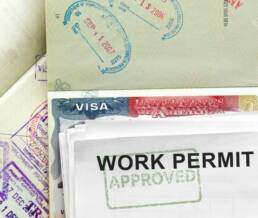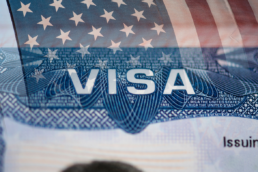There are numerous options available to foreign nationals who wish to enter the U.S. and work on a temporary basis. The first step is acquiring a nonimmigrant visa or work permit. This allows an individual to enter and work in the States for a limited period of time. The application process begins with an employer filing a paper-based petition with USCIS, and if approved, the beneficiary (foreign national seeking temporary work authorization) may then apply for a visa or work permit at a U.S. Embassy or Consulate abroad.
This process is a little different for citizens of specific countries seeking entry based on specific work permit categories. Thanks to NAFTA, Canadian citizens may apply for L-1 and TN status in-person at a Class A port-of-entry. As an added bonus, this on-the-spot adjudication procedure means that if approved, the beneficiary can begin working that same day. Here is a breakdown of the nonimmigrant categories available to foreign nationals seeking temporary employment in the U.S.:
- NAFTA Professionals (TN): The TN category was created under the North American Free Trade Agreement. It enables citizens of Canada and Mexico to enter the U.S. to engage in business activities at a professional level. The applicant must have a prearranged job with a U.S. employer and be seeking entry in one of the NAFTA listed occupations. The applicant must also meet the qualifications to practice in the profession for which entry is sought. For information on how to apply for a TN work permit, please click on the link and visit our website.
- Intracompany Transfers (L-1): The L-1 is available to individuals who have worked for a foreign company that has a parent, subsidiary, branch or affiliate in the U.S. The beneficiary must have been employed with the foreign company on a full-time basis for at least one year in a managerial or executive position (L-1A), or in a specialized knowledge capacity (L-1B). For information on how to apply for an L-1 work permit, please click on the link and visit our website.
- Business Visitors (B-1): A business visitor may enter the U.S. to conduct business activities that are “necessary and incidental” to that individual’s employment abroad, including contract negotiations, attending business meetings, researching options for opening an office in the U.S., etc. It is important to remember that permissible activities are very limited, and any business conducted outside the scope of this visa category will require employment authorization. For information on how to apply for a B-1 visa, please click on the link and visit our website.
- Treaty Traders (E-1): The E-1 category enables a foreign national of a treaty country to seek entry, or send a qualifying employee to the U.S. for the sole purpose of engaging in international trade. To qualify, the treaty trader must carry on substantial and principal trade between the U.S. and the treaty country. For information on how to apply for an E-1 work permit, please click on the link and visit our website.
- Treaty Investor (E-2): The E-2 nonimmigrant classification allows a national of a treaty country to be admitted to the U.S. when investing a substantial amount of capital in a U.S. business. The treaty investor must be investing a substantial amount of capital in a bona fide U.S. company, and be seeking to enter the States for the sole purpose of developing and directing the investment enterprise. For information on how to apply for an E-2 work permit, please click on the link and visit our website.
- Specialty Occupation (H–1B): The H-1B category enables professionals to enter and work in the U.S. in a specialty occupation. Generally, this is defined as a position that requires at least a bachelor’s degree or the equivalent. Before filing an H-1B application, a Labor Condition Application (not to be confused with a Labor Certification) must be certified by the Department of Labor. For information on how to apply for an H-1B work permit, please click on the link and visit our website.
- Specialty Occupation Professionals from Australia (E-3): The E-3 category applies only to citizens of Australia. The beneficiary must be coming to the U.S. to work in a specialty occupation. This requires a theoretical and practical application of a body of specialized knowledge, and the attainment of at least a bachelor’s degree in the specific specialty. For information on how to apply for an E-3 work permit, please click on the link and visit our website.
- Individuals with Extraordinary Ability or Achievement (O-1): The O-1 classification is broken down into two subcategories. The O-1A, which is reserved for individuals with extraordinary ability in the sciences, education, business or athletics, and the O-1B, which includes individuals with extraordinary ability in the arts, or extraordinary achievement in the motion picture or television industry. For information on how to apply for an O-1 work permit, please click on the link and visit our website.
- Individual or Team Athlete, or Member of an Entertainment Group (P-1): The P-1 category enables foreign nationals to enter the U.S. temporarily to perform at a specific athletic competition (P-1A), or to perform as a member of an entertainment group that has been recognized internationally as outstanding for a sustained and substantial period of time (P-1B). Essential support personnel who perform services which cannot be readily performed by a U.S. worker are also eligible for P-1 classification. For information on how to apply for a P-1 work permit, please click on the link and visit our website.
If you are interested in temporarily working in the United States and would like to discuss your options, please contact our office to setup a consultation with one of our attorneys today!
Ready to have Berardi on your side?
Whether you’re a business looking to hire or a professional hoping to relocate, immigration law can be complicated. But you don’t have to do it alone. Put our experience to work for you.



